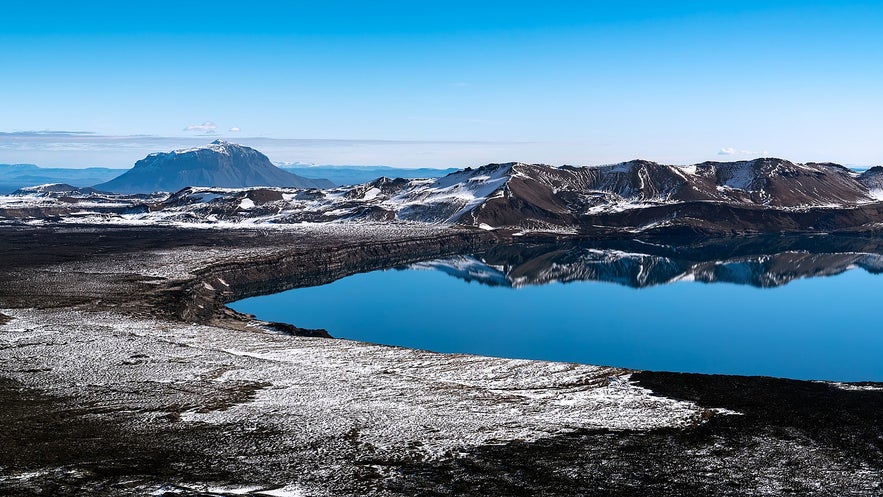Askja Travel Guide

Askja is a caldera in the central Highlands of Iceland, just north of Vatnajökull glacier. It is best known for its dramatic eruptions, as well as the training grounds for Apollo astronauts because of its otherworldly, lunar landscapes.
Browse a wide range of tours of the Highlands of Iceland.
Photo above from Wikimedia, Creative Commons, by Ilya Grigorik. No edits made.
The highest point of the mountains forming the crater is 1,510 metres (4.954 feet), which is remarkably tall for an Icelandic peak.
Askja is a popular destination for hikers, with mountain huts to reside in, although it can only be accessed in summer with a four-wheel-drive vehicle.
Major eruptions at Askja
Askja was not known as a feature of note throughout most of Iceland’s history; it would only gain significant attention in 1875 when it erupted with great force and poured poisonous ash across much of the East Fjords; this ash reached as far as Poland, to give some idea of the scale.
The effect on the local people was catastrophic, as livestock and crops wilted and died. This forced a major wave of emigration from the country to the United States and Canada, and many towns on their East Coasts have high populations of Icelandic descendants, particularly the Canadian town of Gimli.
Though this appeared to be the first time Askja was known to have an international impact, it was not; 11,000 years ago, tephra from its eruption got as far as Romania.
Askja last erupted in 1961, though to no such significant extent. It has, however, rumbled since, with there being tremors in the region in 2010, and no ice cap in April in 2012, indicating heat below the peak.
 Photo from Wikimedia, Creative Commons, by Ulrich Latzenhofer. No edits made.
Photo from Wikimedia, Creative Commons, by Ulrich Latzenhofer. No edits made.
Öskjuvatn lake
Askja is also well known for being home to the second deepest lake in Iceland, Öskjuvatn, which misses out on the top spot for the newly formed Jökulsárlón glacier lagoon.
Lying about 50 metres (164 feet) beneath the main level of the caldera floor, it has depths of up to 220 metres (722 feet).
This lake was formed after the 1875 eruption and covers an area of twelve square kilometres (about five square miles). It is frozen the majority of the year, and if unseasonably liquid, a worrying sign of a potential eruption.
Science and Askja
Askja sits in what is called the ‘rain shadow’ of the great Vatnajökull glacier. This means that the area is remarkably dry, with only 450 mm of rain annually, about half of what falls in Reykjavík. It is also particularly cold, due to its elevation and proximity to the glacier.
These conditions mean that there is little to no vegetation surrounding Askja, and as such, it was a perfect place for Apollo astronauts to acclimatise to the environment of the moon. While other places around the country, such as the Reykjanes Peninsula were also used, this particular environment was considered the most accurate reflection of a lunar landscape.
The Apollo scientists were far from the only ones to come to Askja, with it attracting meteorologists, geologists, and volcanologists for decades. In fact, before the astronauts came, Askja had already claimed the lives of two people studying it.
In 1907, two scientists from Germany, Walter von Knebel and Max Rudloff, were studying the volcano and took a boat journey out onto the surface of Öskjuvatn. They would never return, nor would any sign of them be seen again, in spite of the hard work of von Knebel fiance, Ina von Grumbkow.
What happened to them has been an enduring mystery, a probable answer to which was finally found in 2014.
A study taken that year in the caldera revealed what effects a landslide can have on the lake. When displaced earth struck its surface, it caused a wave 30 metres (98 feet) tall. Any small boat in its path would have been completely shattered, and it is little wonder why no sign of them has ever been found.
Attractions Nearby
Popular categories

Download Iceland’s biggest travel marketplace to your phone to manage your entire trip in one place
Scan this QR code with your phone camera and press the link that appears to add Iceland’s biggest travel marketplace into your pocket. Enter your phone number or email address to receive an SMS or email with the download link.


















